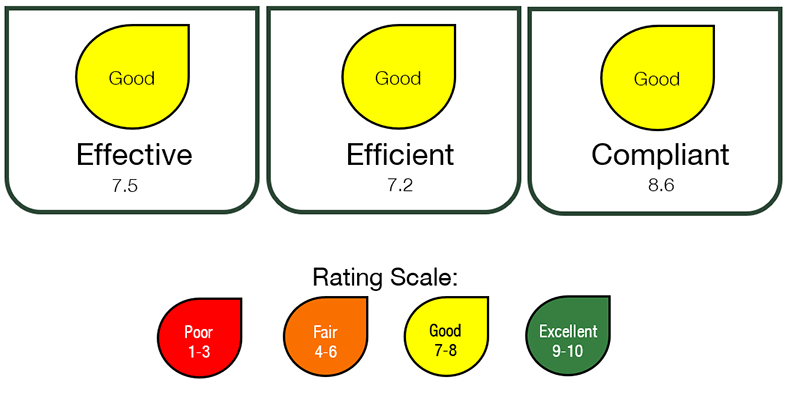Continuous improvement program - 2019-2020 Annual report
Annual Evaluation
Twenty-four randomly selected impact assessments are evaluated each year to see how well they meet the Effective, Efficient and Compliant expected results of the Parks Canada Directive on Impact Assessment.

-
Long text description
Representation of the results of the 2019-2020 Annual Evaluation, according to a rating scale where poor scores are from 1 to 3, fair scores are from 4 to 6, good scores 7 to 8 and excellent are from 9 to 10. The results are good (7.5) in the Effective category, good (7.2) in the Efficient category and good (8.6) in the Compliant category.
Highlights:
- Appropriate impact assessment pathway was chosen.
- Basic Impact Assessments (BIA) were written efficiently.
- High policy and legislative compliance with some gaps.
- Quality of writing in BIAs requires improvement.
Key Recommendations:
- Develop and deliver training on how to write a BIA.
- Revise the BIA template to address gaps.
Key Investigation
The topic of the 2019-20 key investigation was environmental surveillance which contributes to the Effective and Compliant Expected Results. The primary goal of environmental surveillance is to ensure mitigations from the impact assessment are implemented and working as intended when the project is being carried out. The Key Investigation included a 41 question survey of Parks Canada’s Impact Assessment Practitioners and an analysis of the 24 impact assessments selected for the Annual Evaluation.
Highlights:
- Importance of environmental surveillance was confirmed by the fact that mitigation adjustments are usually or always required 51% of the time.
- Existing Parks Canada tools and training are being used and appreciated.
- Majority feel confident in recommending mitigation adjustments in the field.
- There is confidence in determining surveillance requirements for projects.
- Reports of mitigations not working or not being followed are usually or always satisfactorily resolved 80% of the time when raised to the Project Manager.
- Majority determine level of surveillance required using professional judgement rather than employing a formal approach and it is not always discussed with their supervisor.
- Recognition of the Environmental Surveillance Officer role is required, including its importance to success of the project.
- Clarification of roles related to surveillance is required at all levels.
- Challenging communications and decision-making was a consistent theme.
- There are inconsistencies and gaps in how surveillance results are documented and saved to the project file.
- Diligence is required with respect to Occupational Healthy & Safety and harassment:
- Most are educated about safety risks on a project site and feel safe however there are mental health issues that need to be addressed.
- Parks Canada staff are experiencing various forms of harassment mostly from the public, including contractors (79%), but also from coworkers and individuals with authority over them.
- Environmental Surveillance Officers report a higher level of harassment as compared to other federal government employees.
- Respondents were less satisfied with how matters related to harassment were resolved as compared to other federal government employees.
Key Recommendations:
- Share results across Parks Canada including project and asset management, resource conservation and Senior Management to highlight the role of environmental surveillance and the need to address harassment issues.
- Revise impact assessment forms to include more detail on need for and level of environmental surveillance required for projects.
- Develop a digital Environmental Surveillance System to record results more efficiently in the field.
- Develop and deliver training on the new system and roles related to environmental surveillance.
- Find solutions to prevent harassment of Parks Canada staff from contractors.
- Date modified :